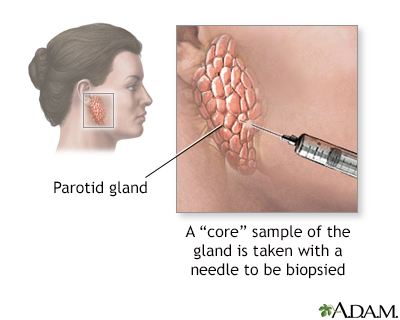Salivary gland biopsy
Definition
Salivary gland biopsy is the removal of cells or a piece of tissue from a salivary gland for exam.
Alternative Names
Biopsy - salivary gland
How the Test is Performed
You have several pairs of salivary glands that drain into your mouth:
- A major pair in front of the ears (parotid glands)
- Another major pair beneath your jaw (submandibular glands)
- Two major pairs on the floor of the mouth (sublingual glands)
- Hundreds to thousands of minor salivary glands in the lips, cheeks, and tongue
One type of salivary gland biopsy is a needle biopsy.
- The skin or mucous membrane over the gland is cleaned with rubbing alcohol.
- A local pain-killing medicine (anesthetic) may be injected, and a needle is inserted into the gland.
- A piece of tissue or cells are removed and placed on slides.
- The samples are sent to the lab to be examined.
A biopsy can also be done to:
- Determine the type of tumor in a salivary gland lump.
- Determine if the gland and tumor need to be removed.
An open surgical biopsy of the minor salivary glands in the lips or the parotid gland can also be performed to diagnose diseases such as Sjogren syndrome.
How to Prepare for the Test
There is no special preparation for a needle biopsy. However, you may be asked not to drink or eat anything for a few hours before the test.
For surgical removal of a tumor, preparation is the same as for any major surgery. You will not be able to eat anything for 6 to 8 hours before the surgery.
How the Test will Feel
With a needle biopsy, you may feel some stinging or burning if a local numbing medicine is injected.
You may feel pressure or mild discomfort when the needle is inserted. This should only last for 1 or 2 minutes.
The area may feel tender or be bruised for a few days after the biopsy.
The biopsy for Sjogren syndrome requires an injection of the anesthetic in the lip or in the front of the ear. You will have stitches where the tissue sample was removed.
Why the Test is Performed
This test is done to find the cause of abnormal lumps or growths of the salivary glands. It is also done to diagnose Sjogren syndrome.
Normal Results
The salivary gland tissue is normal.
What Abnormal Results Mean
Abnormal results may indicate:
- Salivary gland tumors or infection
- Sjogren syndrome or other forms of gland inflammation
Risks
Risks from this procedure include:
- Allergic reaction to the anesthetic
- Bleeding
- Infection
- Injury to the facial or trigeminal nerve (rare)
- Numbness of the lip
Gallery

References
Miloro M, Kolokythas A. Diagnosis and management of salivary gland disorders. In: Hupp JR, Ellis E, Tucker MR, eds. Contemporary Oral and Maxillofacial Surgery. 7th ed. Philadelphia, PA: Elsevier; 2019:chap 21.
Orlowski HLP, Miller-Thomas M. Diagnostic imaging and fine-needle aspiration of the salivary glands. In: Flint PW, Francis HW, Haughey BH, et al, eds. Cummings Otolaryngology: Head and Neck Surgery. 7th ed. Philadelphia, PA: Elsevier; 2021:chap 82.